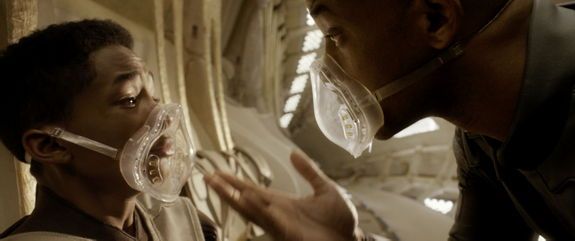
Danger is real. Fear is a choice.
That's the tagline for the movie "After Earth," opening in movie theaters May 31, which takes place 1,000 years from now, after humans flee a hostile Earth to settle on a new planet called Nova Prime.
There, enemy life-forms create killing machines that hunt humans by smelling their fear. To fight the deadly hunters, Will Smith's character, Cypher, has taught humans a technique called ghosting — essentially emptying oneself of fear to become invisible to the monsters. [See Images From "After Earth" Movie]
Though the movie is science fiction, there's some hint that people may be able to smell fear. And people do drown out fear or see fear transform into bliss in frightening situations, though it's usually not a conscious choice, says one researcher.
"That does seem to happen on a regular basis. People are in very fearful states, and then they flip into a blissful state," said Dr. Jon Lieff, a psychiatrist and past president of the American Association for Geriatric Psychiatry, who blogs at jonlieffmd.com.
Fear response
Fear causes the body to produce some distinctive chemicals that can be sensed, a phenomenon that may explain how people can smell fear and even why evidence suggests the smell of fear is contagious.
Sign up for the Live Science daily newsletter now
Get the world’s most fascinating discoveries delivered straight to your inbox.
Ghosting, or the process of emptying oneself of fear, on the other hand, may have parallels with normal physiological responses.
"There's a natural process of dampening of fear," Lieff told LiveScience.
Scary situations normally activate neural circuits in brain regions that produce fear, such as the amygdala. But immediately after a person senses the threat, another circuit works to dampen that fear, Lieff said.
In extreme situations of fear, the adrenaline pumping through someone's body initially makes them hyper-alert and insensitive to fear and pain. For instance, when soldiers are bombed in battle, "at first, they don't really feel anything, and they look around and see their buddy's leg is knocked off — so they lean down, pick them up and drag them behind a wall," Lieff said. "When they can catch themselves, at that point, they start having pain and fear."
Sometimes, however, prolonged periods of fear trigger the formation of new connections between brain cells — essentially routing around fear-dampening circuits to reactivate fear. This process plays a role in the formation of traumatic memories and PTSD.
Cool in crisis
Occasionally, however, people feel their terror transform into bliss, though they are not consciously choosing to do so.
For instance, people taking psychedelics, or those experiencing near-death experiences or extreme blood loss, may report spiritual encounters that follow moments of fearful awe or sheer terror.
No one knows exactly why this happens, but Lieff has some ideas.
The sympathetic nervous system revs up the fight-or-flight response due to fear — expanding airways, slowing time as people's thoughts race and pumping blood to the extremities to bolt or fight in a moment's notice. But the parasympathetic nervous system, which is active when people are at rest, is responsible for initiating relaxation and the dreamlike state of REM sleep, Lieff said.
When a person is in REM sleep, when most dreaming occurs, the body is paralyzed and the judgment centers of the brain are quiescent, Lieff said. But the rewards centers are active, leading to the amazing feeling of, for example, flying off a bridge — without fear or a mental check to say, "No way that would work!"
One possible explanation is that in these ultra-scary situations, the parasympathetic nervous system drowns out the sympathetic response, creating a blended state between sleep and wakefulness, and morphing fear into bliss, Lieff said.
Follow Tia Ghose on Twitter and Google+. Follow LiveScience @livescience, Facebook & Google+. Original article on LiveScience.com.

Tia is the managing editor and was previously a senior writer for Live Science. Her work has appeared in Scientific American, Wired.com and other outlets. She holds a master's degree in bioengineering from the University of Washington, a graduate certificate in science writing from UC Santa Cruz and a bachelor's degree in mechanical engineering from the University of Texas at Austin. Tia was part of a team at the Milwaukee Journal Sentinel that published the Empty Cradles series on preterm births, which won multiple awards, including the 2012 Casey Medal for Meritorious Journalism.











